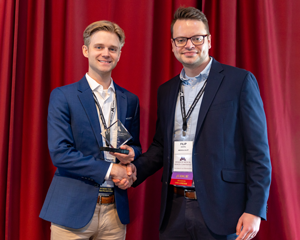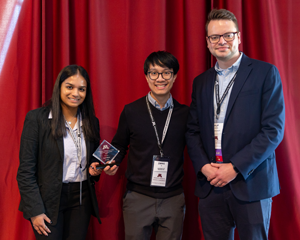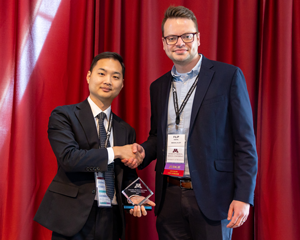Researchers and inventors will get immediate feedback about their projects from leaders in the fields of medical technology research, engineering & development.
Winners will be announced during lunch following the competition on Tuesday.
Axi-FLEX Fracture Fixation Plating System (Grand Prize Winner)

A mechanically compliant (flexible) fracture fixation plate capable of delivering controlled axial motion for long bone healing.
Presenting Author: Connor Huxman, PhD Student, Mechanical Engineering, The Pennsylvania State University
Connor has been designing orthopaedic devices in industry and academia for the last four years. This has included working as an R&D engineer at a start-up on the design and regulatory approval of spinal fusion implants, as well as academic research on the design of new devices for fracture fixation. He received his B.Sc. in Biomedical Engineering in 2020 from the University of Waterloo (Ontario, Canada), his M.S. in Engineering Design in 2022 from Penn State University, and is currently working towards his PhD in Mechanical Engineering at Penn State. Connor is passionate about the intersection of orthopaedic implant design, regulatory strategy, and surgeon adoption. He is currently developing a new technology for delivering controlled motion to long bone fractures with the goal of facilitating faster and stronger bone healing.
inSTENT Connection (2nd Pace Winner)

The inSTENT is the first bioresorbable intestinal stent and compressive band combination for safely and effectively creating surgical connections within the gastrointestinal (GI) tract. Traditional methods of reconnecting intestine segments following resections within the GI tract are associated with alarming leakage and mortality rates. The patent-pending inSTENT device can be used to reconnect intestinal segments without staples, sutures, and the risks and consequences of intestinal leakage. The inSTENT is completely bioresorbable, meaning that after healing takes place, both the stent and the band will be degraded and absorbed by the body, eliminating the need for an additional surgical procedure to remove the device.
Presenting Author: Gillian Pereira, Graduate Student, University of Washington
Gillian is a graduate student in the department of Materials Science and Engineering at the University of Washington. She has been conducting research on biomaterials for tissue engineering applications for the past two years. She graduated with a B.Sc in Materials Science and Engineering and a BA in Biochemistry in 2022 from UW, and has worked in the startup space since graduation. She is enthusiastic about studying the intersections of engineering and medicine and doing research on medical devices and therapeutics.
Presenting Author: Ziming (Jimmy) Ye, Systems Engineer, Apton Biosystems
Jimmy is a systems engineer at Apton Biosystems and received his B.Sc in Chemical Engineering and B.A in Biochemistry from the University of Washington in 2022. He has three years of disease directing engineering research experience and has been working in the startup space since graduation. He is passionate about the intersection of engineering and medicine and how you can take these innovations out of the laboratory and into the hands of people who need them.
Robotic Flexible Ureteroscopy System : Zamenix (3rd Place Winner)

Zamenix is a Robot platform that lets endourologists conduct robotic retrograde intrarenal surgery (RIRS). Robotic RIRS via Zamenix enables stable, precise lasing and safer extraction of renal stones while protecting the surgeon from radiation emitted from the fluoroscopy device. The enhanced precision and the surgeon's protection from fatigue and radiation is expected to show overall enhanced clinical outcome such as stone free rate and complication rate.
Presenting Author: John Kwon, Business Strategy Lead, ROEN Surgical
ROEN Surgical is a group of innovators in the field of flexible surgical robotics. Rooting from KAIST (Korea Advanced Institute of Science and Technology), ROEN Surgical was founded by nine mechanical engineering doctorates with an accumulation of 25 years of surgical robotics research. With its research insights and intellectual properties, ROEN Surgical is commercializing multiple surgical robot platforms starting with the Zamenix, the flexible ureteroscopy robot for renal stone treatment.
The Sonura Beanie
Sonura, LLC (Sonura) was founded by Tifara Boyce, Gabriela Cano, Gabriella Daltoso, Sophie Ishiwari, and Caroline Magro, a team of bioengineers at the University of Pennsylvania. Its key product, the Sonura Beanie, was developed to promote the cognitive development of newborns in the NICU, while protecting them from the auditory hazards of their environments. Specifically, the Sonura Beanie relies upon two primary properties, including the (1) removal of dangerous noises and (2) transmission of parental audio recordings, to achieve these goals. Sonura is advised by experts in biotechnology, regulatory affairs, and clinical integration, and its team strives to enable every newborn to pursue a brighter future.
Presenting Authors: Gabriela Cano, Sonura COO & Bioengineering Undergraduate at the University of Pennsylvania
Caroline Magro, Sonura CTO & Bioengineering Undergraduate at the University of Pennsylvania
NeoAnalyzer1.0
A system for neonatal biomarkers analysis from a single droplet of blood. Our system will allow for accurate and fast analysis of three biomarkers in blood to make medical decisions faster, while using less sample volume to avoid worrying about risks associated with excessive blood draws.
Presenting Author: Alan M. Gonzalez-Suarez, Senior Scientist at Sersense Inc. & Engineer, Mayo Clinic
Sersense Inc. is an early-stage start-up with the mission of transforming patient care by developing novel diagnostic technologies. Our company is led by multidisciplinary researchers affiliated with Mayo Clinic in Rochester. We engineer solutions using the power of microfluidics to provide simple point-of-care solutions to complex clinical problems.
DuraBloom
DuraBloom is the first surgical tool capable of both easily elevating the dura 360 degrees around dural defects in the mastoid cavity and deploying a graft between the bone and dura to seal CSF leaks via the transmastoid approach. Surgeons simply position DuraBloom within the defect and push a slider on the handle of the device to separate the dura from the bone and insert a graft. After the graft is in place, the surgeon can then move the slider back, leaving the graft behind to seal the defect and repair the CSF leak. DuraBloom will reduce operating time, overnight patient hospitalization, and potential morbidities from mastoid CSF leak repair surgery.
Presenting Author: Nicole Zimmer, Ph.D. Candidate, Biomedical Engineering, Duke University
Nicole is a Biomedical Engineering Ph.D. Candidate at Duke University. She received a B.S. in Biomedical Engineering from Rensselaer Polytechnic Institute in 2020 and an M.S. in Biomedical Engineering from Duke University in 2022. Her passions include medical device design and development as well as orthopedic biomechanics research.
Competition Judges
Mike Finch, Children's Minnesota / University of Minnesota
Paul Gam, Zurich Medical
Filip Kostal, Medical Alley
John Heinbigner, EY
Mary MacCarthy, University of Minnesota